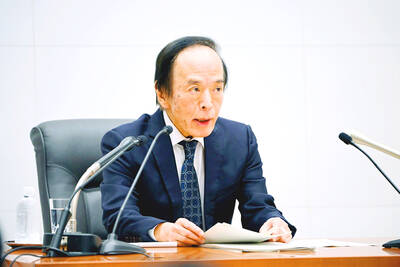Medical device maker Microlife Corp (百略) yesterday said revenue would rise by 4 to 5 percent this year from last year on expectations of higher sales of its new sphygmomanometers.
The company aims to increase shipments of its new sphygmomanometers, launched in the middle of last year, by 30 percent this year from 250,000 units last year, vice president Edith Huang (黃雅絹) said.
The new product is priced at NT$4,500 (US$149) per unit, compared with NT$2,000 per unit for previous models, Huang said, adding that its gross margin is estimated to be 10 percent higher than earlier versions.
The new machine can measure blood pressure three times and calculate the average, Huang said. It can also test whether a patient has atrial fibrillation, which may lead to myocardial infarction and stroke, he said.
Microlife made the remarks after a ceremony where the company donated 1,000 new sphygmomanometers to 30 local hospitals yesterday.
The company also produces medical thermometers and electric blankets.
The company has set up 24 service points at local drug stores and medical device shops, where people can use its new sphygmomanometers for free. It plans to raise the number of service points to 100 around the nation by the end of this year, Huang said.
“Many Taiwanese still do not recognize the danger of atrial fibrillation, and we believe our new product can help prevent stroke and myocardial infarction,” Huang said.
Microlife sold about 5 million sphygmomanometers a year, accounting for 60 percent of its total revenue, he said.
Last year, the company reported revenue of NT$6.28 billion, up 9.6 percent from NT$5.73 billion a year ago, according to the company’s filing to the Taiwan Stock Exchange.
The US and Europe each accounted for 40 percent of its revenue last year, while Asia contributed 20 percent, Huang said.
Last quarter, Microlife saw revenue increase 4.53 percent to NT$967.15 million from NT$925.22 million the previous year.
Huang said the company’s revenue is expected to rise sequentially this quarter and next quarter, but would decline slightly in the fourth quarter.
The company posted a stronger performance in the second half of last year because it started to sell electric blankets in the third quarter, Huang said.
Microlife shares rose 1 percent to NT$80.70 yesterday, outperforming the over-the-counter index, which advanced 0.37 percent.

Taiwan’s long-term economic competitiveness will hinge not only on national champions like Taiwan Semiconductor Manufacturing Co. (TSMC, 台積電) but also on the widespread adoption of artificial intelligence (AI) and other emerging technologies, a US-based scholar has said. At a lecture in Taipei on Tuesday, Jeffrey Ding, assistant professor of political science at the George Washington University and author of "Technology and the Rise of Great Powers," argued that historical experience shows that general-purpose technologies (GPTs) — such as electricity, computers and now AI — shape long-term economic advantages through their diffusion across the broader economy. "What really matters is not who pioneers

In a high-security Shenzhen laboratory, Chinese scientists have built what Washington has spent years trying to prevent: a prototype of a machine capable of producing the cutting-edge semiconductor chips that power artificial intelligence (AI), smartphones and weapons central to Western military dominance, Reuters has learned. Completed early this year and undergoing testing, the prototype fills nearly an entire factory floor. It was built by a team of former engineers from Dutch semiconductor giant ASML who reverse-engineered the company’s extreme ultraviolet lithography (EUV) machines, according to two people with knowledge of the project. EUV machines sit at the heart of a technological Cold

TAIWAN VALUE CHAIN: Foxtron is to fully own Luxgen following the transaction and it plans to launch a new electric model, the Foxtron Bria, in Taiwan next year Yulon Motor Co (裕隆汽車) yesterday said that its board of directors approved the disposal of its electric vehicle (EV) unit, Luxgen Motor Co (納智捷汽車), to Foxtron Vehicle Technologies Co (鴻華先進) for NT$787.6 million (US$24.98 million). Foxtron, a half-half joint venture between Yulon affiliate Hua-Chuang Automobile Information Technical Center Co (華創車電) and Hon Hai Precision Industry Co (鴻海精密), expects to wrap up the deal in the first quarter of next year. Foxtron would fully own Luxgen following the transaction, including five car distributing companies, outlets and all employees. The deal is subject to the approval of the Fair Trade Commission, Foxtron said. “Foxtron will be

INFLATION CONSIDERATION: The BOJ governor said that it would ‘keep making appropriate decisions’ and would adjust depending on the economy and prices The Bank of Japan (BOJ) yesterday raised its benchmark interest rate to the highest in 30 years and said more increases are in the pipeline if conditions allow, in a sign of growing conviction that it can attain the stable inflation target it has pursued for more than a decade. Bank of Japan Governor Kazuo Ueda’s policy board increased the rate by 0.2 percentage points to 0.75 percent, in a unanimous decision, the bank said in a statement. The central bank cited the rising likelihood of its economic outlook being realized. The rate change was expected by all 50 economists surveyed by Bloomberg. The